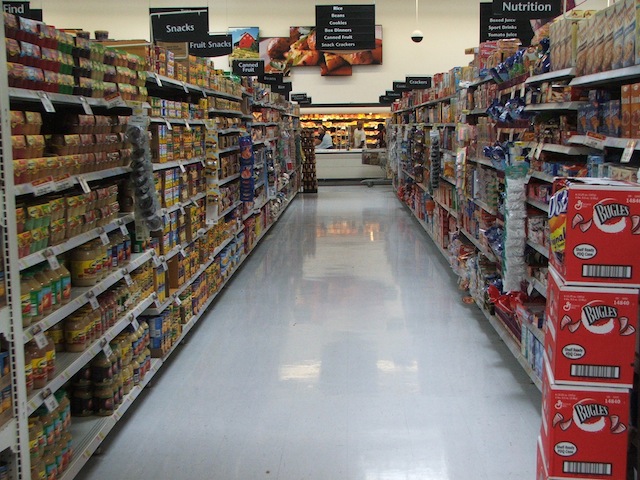Share the post "How often to shop? Plan your time and money."
Do we really love popping into the market every day or two to pick up fresh produce, something the kids requested for dinner or something we forgot? Don’t you ever think to yourself, “How I wish I could do this just once a week!”
And really, if you add up the time you spend driving, parking, shopping, loading bags into the car, pulling bags out of the car—you are probably spending an extra 3-5 hours a week shopping that you could be spending relaxing with your family. Impulse shopping is also much, much more expensive than planned shopping.
It is entirely possible to limit the amount of time and money you spend shopping with just a little bit of planning. With the help of standardized pantry lists and a little mental reprogramming, you can become a shopping wizard.
Plan and organize your list
The first step is to build your own customized . Look in your pantry and fridge and really study your dietary and buying habits, then build a list that realistically addresses your preferences and needs. I find it helpful to list items under these categories, but you can choose your own:
- Meat/Protein
- Dairy
- Grains
- Breakfast
- Vegetables
- Fruit
- Canned
- Beverages
- Baking
- Personal
- Pantry
- Pets
- Paper Goods
- Cleaning Supplies
Some items, like meat or produce, you may prefer to purchase at a premium or specialty market and it helps to have a weekly list to reduce the number of trips and impulse purchases. Other items, like cleaning supplies, are much cheaper when purchased in larger sizes or at discount stores.
Think in menu groups
Planning a week’s menu in advance is helpful if you want to save money and time, but let’s face it—how many of us really stick to our plan? But if you learn to think in terms of “menu groups” then you’ll always have something quick and easy to pull together. For instance, make sure you’ve always got enough meat, starches and vegetables on hand for three protein+carb+vegetable meals. If you or your family like to have a pizza night, or turn to pizza for those exhausting, busy days when there’s little time for anything else, stock up on pizza doughs, canned tomato sauce, bulk shredded mozzarella, and toppings. Homemade pizza is much cheaper (and more delicious) than expensive frozen versions, or delivery. Pasta and risotto are two wonderful basics that you should always have on hand (assuming no dietary restrictions). Stock some tomato and white sauces in the pantry and you can whip up a quick meal with leftover chicken or seafood, some random vegetables, and some penne or linguine. Keep some chicken broth on hand and you can make a satisfying, aromatic risotto with practically any leftover meats and vegetables.
Buy multi-purpose foods
Like pasta and risotto, some foods are always a good investment. Broths can be used in risotto, soups, crockpot dishes or drunk as a beverage. Another multi-purpose example are avocados—although they can be expensive, they can be used in small amounts in salads or omelettes, and when they get mushy they’re great for homemade guacamole. Having foods on hand that you can prepare in a variety of ways will help you prevent unnecessary trips to the store.
Fads are NOT your friend
Fad diets and advice are not a friend of your time and money budgets. Those protein shakes that are so frequently promoted as being great for your waistline? They’re really designed for people who are already athletes or working out intensely. Unless you’re spending an hour or more in the gym every day, you’ll be better off planning a diet that incorporates a wide variety of fresh, fibrous, healthy foods.
Smell the vine-ripened tomatoes in the store. Do they really smell fresh off the vine? If not, they were probably ‘vine-ripened’ in cold storage. In that case, you’ll be better off buying plain old plum (Roma) tomatoes which are less prone to bruising and rot, will last longer, and taste just as good.
Instead of buying ‘lean’ cuts of meat and skinless chicken, you’ll get better value (and flavor) by buying bone-in cuts and large packs of chicken cuts with the skin on. These are the best cuts for roasting and crockpot cooking, plus the fat in the skin makes it unnecessary to add butter or oil, while adding flavor to vegetables and other starches. Or, just remove the skin yourself and either toss it, freeze it, or make tasty pet treats from it.
The freezer IS your friend
Many people under-utilize their freezer, cramming it with kid treats, expensive frozen dinners, or leftovers that will probably never get eaten.
Buy your meat in bulk packs to save money, and as soon as you get home, separate cuts into resealable baggies in sets of 2-3 cuts per bag. Instead of buying over-priced and highly over-salted canned soups, make one big pot of delicious homemade soup a week (see Mr. Sunday’s Soups for inspiration) and freeze the leftovers in small resealable containers. (Although I think you’ll be surprised at how quickly a family can polish off even a big pot of soup or gumbo.)
A customized shopping list is the number one key to making good use of your time and money. And with practice, you’ll even begin to think differently about how you shop and spend.
«Buy Me a Pie!» — the most convenient, easy and elegant grocery list application :(iPhone/iPad) | (Android) |
Share the post "How often to shop? Plan your time and money."








 EN
EN  RU
RU